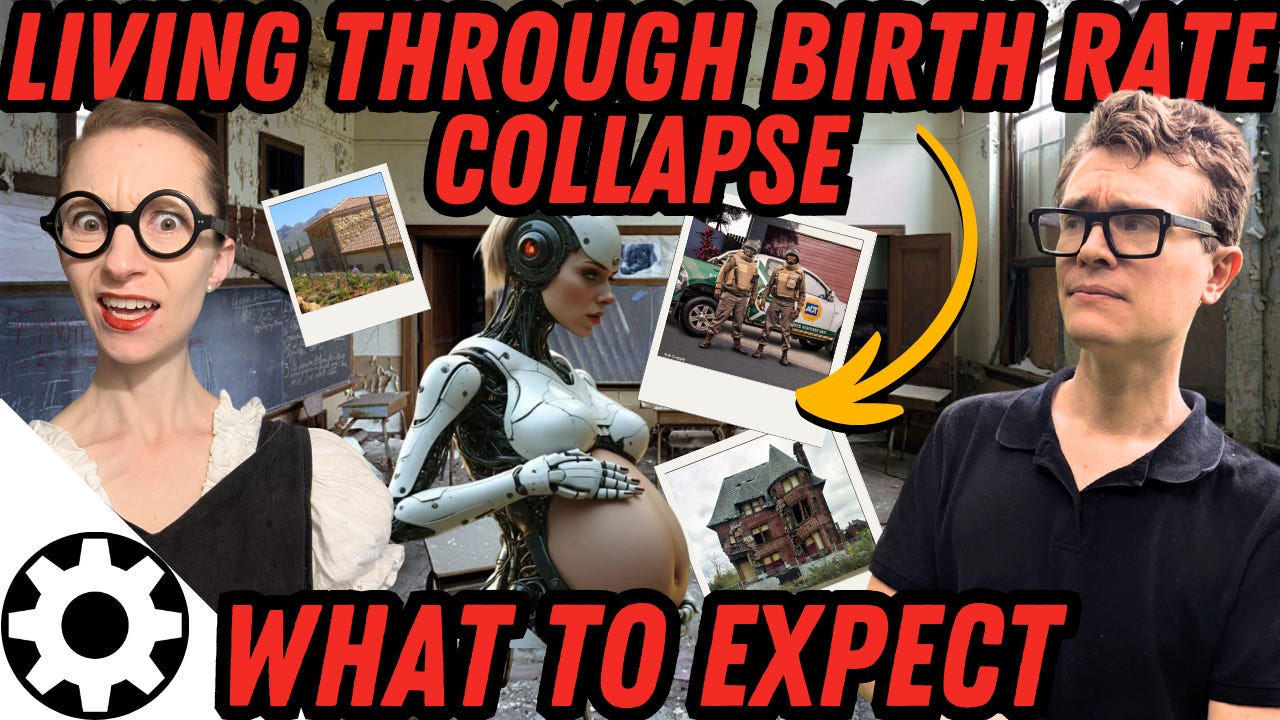What Does A Birth Rate Collapse Future Look Like?
Description
In this episode, Malcolm and Simone explore the onset and implications of demographic collapse. From dystopian AI-managed cities to the technological advancements in artificial wombs, the Collinses discuss the possible futures and scenarios we might face in the next 150 years. The conversation includes detailed insights into how collapsing demographics will impact everything from urban infrastructure to social security. By examining current examples from cities like Detroit and nations like China, they predict what life could be like in the coming decades. The couple also outlines practical steps to prepare for a radically changing world economy, including advice on financial diversification, medical self-care, and home security. Whether it’s the bizarre concept of humanoid robots carrying artificial wombs or the perilous future of nationalized healthcare and social security, this episode aims to provide a comprehensive guide to navigating the uncertainties ahead.
Episode Transcript:
Simone Collins: [00:00:00 ] Hello, Malcolm. I'm so excited to be with you today because we are going to talk about what it's actually like to live through demographic collapse, which really matters because. It's already kind of starting. As William Gibson said, the future is here.
It's just not evenly distributed. We're gonna go through the good, the bad, the ugly. And I think we're gonna start off with the weird, like artificial wounds being developed in robot humanoid form. So it's gonna fun.
Malcolm Collins: This is in China, but this is happening and I, I'll argue that it's probably not real. It's 100% almost certainly not real, but still I'm very artificial ones are being developed.
But what I I, the core point of this episode that we're gonna be going over with you guys. Is, what does it actually feel like to live through a demographic collapse, apocalypse scenario? Mm-hmm. What does the world look like in 150 years? And what, and, and keep in mind we're we will be modifying this with what does this look like?
Positive AI timelines in neutral AI timelines because it's a huge modifier on how this plays out is ai. You know, you Yeah. [00:01:00 ] Although
Simone Collins: in some ways AI, I'm gonna argue is gonna make things worse, faster for people, so, oh, I agree. It
Malcolm Collins: absolutely will. But, but what I mean here is in my AI scenarios was in the original.
Timeline. AI doesn't come online enough to fix everything. And you get a post apocalypse. It'll create some for R Fab AI that, that have this scenario eventually. But anyway this is, this is like. My day SX world, right? Where, you know, our distant descendant 150 years from now is exploring mostly decayed buildings with like a, a slap drone, right?
And cities, you can't even walk in them because they're so dangerous. 'cause things can collapse. What if the AI comes online and decides to keep everything up and running? Right. And so it as a function of just, its, its maintenance function ends up keeping up all the roads in all the cities and you just end up with like eerily empty cities with like a very large in bustling like Orthodox Jewish quarter.
But like everything outside of that is, is, is mostly just empty [00:02:00 ] policed by AI drones. So you can't go out and like break the law or steal something. That could be the very weird and real future that our distant descendants could be living through. So let's talk about what these different futures could look like.
Simone Collins: Yeah. And since this just came out in the news and we've gotta talk about it because. This is how things are gonna get weird. Probably not through this method, but through others. Yeah. Some Chinese scientist has, has announced that he's going to create a humanoid robot that will gest state humans according to chosen Biz.
An article titled China Develops Pregnancy Robot with Artificial Womb to eight Infertile Couples. It reads, reports have emerged. The world's first pregnancy robot is under development in China. The robot is designed in a human. Human humanoid form and is equipped with an artificial womb in its abdomen, allowing it to carry a fetus for 10 months and give birth.
A prototype is expected to be released next year with a selling price of around one thou 100,000 Yuan, approximately one 19.3 million. Juan. So the, the scientist, sorry,
Malcolm Collins: sorry. Seems to be like for, for, for [00:03:00 ] context for our audience that's around 14,000 US dollars. Yeah. So like
Simone Collins: this is 100% not gonna happen.
One, it's insane. Like, why would you. Why would you put an artificial womb in a humanoid robot? I mean, one thing that, that, that's really weird is so the, the article also reads, the key to the pregnancy robot is the artificial womb technology where the fetus grows inside the artificial womb filled with amniotic fluid and receives nutrients through a hose.
Dr. Zang noted quote, the artificial wound technology is already in a mature stage and now it needs to be implanted in the robot's abdomen so that a real person and the robot can interact to achieve. Pregnancy, allowing the fetus to grow inside. I don't know if he wants people to have intercourse with the robot.
This is the most fake China thing I have ever seen, ever. It's beyond fake because I mean, if you're developing an artificial loom, really, like from embryo onward, like you are developing something where the, the, the placenta is also growing in there and the way that.
Malcolm Collins: For [00:04:00 ] context, we have a lot of knowledge about artificial womb development beyond what the art of normal person would, because this is a space we are very interested in potentially very passionate about it investing in.
And we're very passionate about it. And so I am aware of the state of the current technology, and this is like somebody comes out there and is like, I have a phaser, right? It's like.
Speaker 3: I am aware
Malcolm Collins: of the cutting edge technology. You don't have a phaser like we, we, I have teleportation or something, right?
Like, it's like No, you don't have teleportation. Yeah. We are at least I'd say maybe six years away from being able to do this in humans, from my knowledge of the current technology. Yeah. And it's
Simone Collins: not gonna look like a humanoid robot. This reminds me of those, those examples of early AI robots in China where like clearly there was just a person.
He's speaking to a mic also. Oh yeah. There's,
Malcolm Collins: there's this really funny thing. So early in China, they did the thing where they were doing like cutting edge AI at this. They were like, we've done it,
Simone Collins: people we've developed
Malcolm Collins: in, in Singapore. And the person went up to it, the ai and they could converse with it in English and they could converse with it was in the, the Singapore language, [00:05:00 ] but it couldn't talk in Mandarin, the Chinese language.
This is could only just a person.
Simone Collins: But anyway, that's great. Yeah. But also like the way that it spoke was kind of like, yeah, no. So like while this is totally bunk, one, there will absolutely be artificial wounds fairly soon, and two, China is absolutely gonna get on this kind of tech because it is going to probably be, we would, we would argue the first country that is going to start.
Printing essentially. Sure. Its own citizens. Oh, absolutely. So, so when people
Malcolm Collins: are like, no, China wouldn't do, China would absolute. That's exactly the type of thing China would do. Yeah. Come on guys. So for people who dunno during the one child policy, if you was in certain districts, if you'd go in for like a cold, they'd give you like a forced abortion.
Like why, why wouldn't they do forced inseminations if you go in for a cold or something like that? Right. Like, they, they, they, the, the. Government there when things get bad enough and when they finally recognize it. And keep in mind things are bad there right now. Mm-hmm. They have tried to force people to have more kids through [00:06:00 ] differential sort of government.
Like it's hard to move up in the government if you don't have at least three kids now.
Simone Collins: Yeah. But it's still super trending in the media constantly. In China. Is, is just sort of stuff that's going viral of people talking about why they can't have three kids, like most recently in this reality TV show this celebrity couple.
Was discussing how well they had originally pledged to only have one child, and then the husband's kinda like, well, I, I kind of like two kids. And the mother's like, listen, like you're not helping me at all. And like sort of this, this conversation that played out publicly on reality tv. And I'm kind of shocked the CCP allowed them to play this rush.
I would not allow this, they, the social media sort of erupted in support of the wife who was like, I'm not having more kids. And in criticism of the husband, like, how dare you say that you want more children, he argued like it would help with his artistic inspiration or something, and his dad died and it made him rethink, you know, the importance of fatherhood and stuff like that.
So constantly, like as much as the government's trying to shift the narrative, it's super not working in. Even mainstream media?
Malcolm Collins: No, it's
Simone Collins: their only
Malcolm Collins:</strong
























